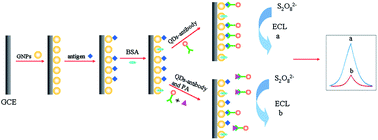Jianguo Li*ab (李建国)
a College of Chemistry, Chemical Engineering & Materials Science, Soochow University, Suzhou 215123, China b The Key Lab of Health Chemistry & Molecular Diagnosis of Suzhou, Suzhou 215123, China Analyst 2014, 139, 4365–4372 This study reports the development of an electrochemiluminescent (ECL) immunosensor for ultrasensitive detection of phenylethanolamine A (PA) based on CdSe quantum dots (QDs) and gold nanoparticles (GNPs). The GNPs/ovalbumin–PA/anti-PA–QD immunosensor was fabricated layer by layer using GNPs as substrates and electron transport accelerators. The use of GNPs greatly enhanced the sensitivity for detecting PA due to the excellent electron transportation ability and the large surface area of GNP carriers allowing several binding events of ovalbumin–PA on each nanosphere. Transmission electron microscopy images (TEM), photoluminescence spectra, ultraviolet-visible absorption spectra and dynamic light scattering (DLS) were used to characterize the QDs and GNPs. The sensor was characterized with electrochemical impedance spectra (EIS), and a strong ECL emission of the modified electrode could be observed during the cathodic process of S2O82− and QDs in air-saturated PBS buffer containing 0.1 M K2S2O8 and 0.1 M KCl (pH 7.4). With a competitive immunoassay format, the ECL signal depended linearly on the logarithm of the phenylethanolamine A concentration within a range of 0.02 ng mL−1 to 50 ng mL−1, and the detection limit was 0.0047 ng mL−1, much lower than those reported in the literature. This ECL immunosensor is rapid, simple and sensitive with acceptable precision, and it will extend the application of QD ECL in immunoassays of β-agonists and open new avenues for the detection of food additive residues in the future. 链接: //pubs.rsc.org/en/Content/ArticleLanding/2014/AN/C4AN00378K#!divAbstract